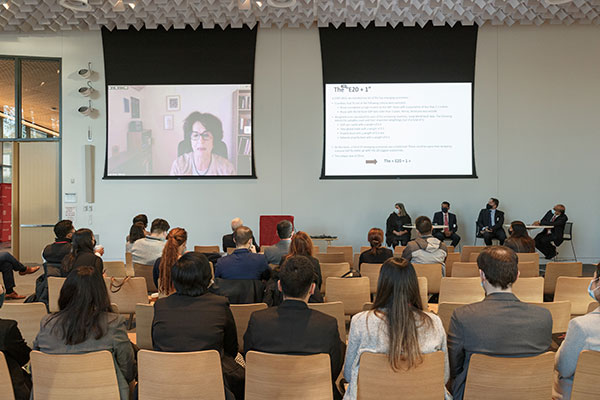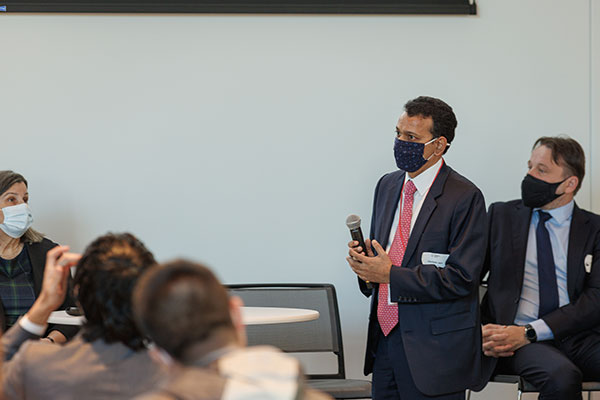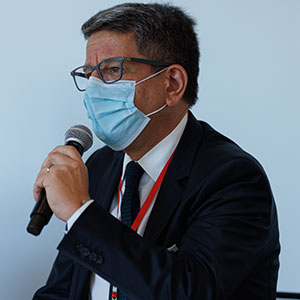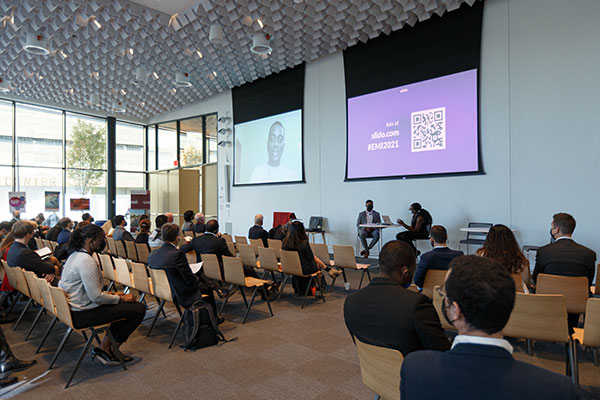ESG pressure takes center stage at the 2021 Emerging Markets Institute conference

A tumultuous and trying year has brought some positive change to the world, panelists and presenters agreed at this year’s Emerging Markets Institute conference. According to new research from the institute, emerging markets are making notable progress in their environmental, social, and governance (ESG) efforts.
Hosted by the Emerging Markets Institute (EMI) at the Cornell SC Johnson College of Business and held at the Cornell Tech campus in New York City, this year’s conference brought together 450 attendees and speakers from 41 different countries on November 5, 2021. Taking place right on the heels of the COP26 climate summit and the IFRS Foundation’s introduction of the International Sustainability Board earlier in November, the EMI event was centered on a timely theme: the future of ESG excellence.

To kick off the day’s discussions, Lourdes Casanova, senior lecturer and Gail and Rob Cañizares Director of EMI, shared key findings from the 2021 Emerging Markets Multinationals Report: Building the Future on ESG Excellence (EMR 2021), which she co-authored. As the pandemic subsides and global economies recover, emerging markets have a central role to play not only in reviving growth and rebuilding the middle class, but also in driving global ESG efforts, the report suggests.
The increasing power of emerging market economies puts them under greater pressure from investors to act on the ESG commitments they’ve made and the mandates they now face. What’s more, over the past 18 months, the COVID-19 pandemic raised awareness around social inequalities like disparities in access to healthcare, while extreme weather events—including record-breaking snowfall in Madrid, European floods, and an unprecedented dust storm in China—continued to underscore the urgency around acting to mitigate climate change.
The result of all these converging factors? Investors and consumers are holding companies in emerging markets increasingly accountable for their ESG practices.
The evolution of emerging markets
In EMI’s first report, 2016 Emerging Market Multinationals Report: China Surge, researchers identified a group of top-20 emerging economies characterized by their growth, development, GDP, population, and influence, dubbed the E20. That E20 list has transformed somewhat over the last five years.
Specifically, while China remains an emerging market as defined by researchers’ criteria, its status as the second-largest economy and one of most innovative countries in the world set it apart from the other countries on EMI’s E20 list. This led the authors of EMI’s 2021 report (EMR 2021) to refer to the emerging markets as E20+, with “+” indicating China. “China is a special case. It’s in its own category,” explained Anne Miroux, EMI faculty fellow and EMR 2021 co-author, who joined the conference remotely.

As emerging markets mature internally, they’re shifting the global business landscape, as well. For example, the U.S. has long dominated the Global Fortune 500 with the highest number of firms listed. This year, China surpassed the U.S. with 135 companies, compared to 122 U.S. companies, EMR 2021 revealed.
With this increased influence, emerging markets are taking big strides towards doubling down on their ESG efforts, Miroux explained. Most of the E20+ countries have made notable progress. For example, the number of Principles for Responsible Investment (PRI) signatories from emerging economies increased by 50 percent in 2020 alone. In fact, emerging economies now account for about 12 percent of all signatories, EMR 2021 states. ESG is at the core of PRI, a set of six principles developed in 2006 by investors for investors and supported by the UN Environment Programme Finance Initiative and the UN Global Compact.
Firms in emerging markets also account for about 23 percent of the UN Global Compact business signatories—Brazil leads with 714 companies. And of the 108 partners of the 2021 Sustainable Stock Exchanges (SSE) Initiative, about 50 are in emerging and developing economies.
Key contributing factors driving these positive ESG changes include the shift in public opinion towards greater environmental and social awareness; access to greater financial opportunities as investors favor businesses taking ESG actions; and domestic policies, regulations, and frameworks aimed at strengthening ESG.
Lack of ESG metrics hinders impact investments
Despite promising growth with regard to ESG initiatives, challenges and opportunities for the E20+ to do more remain. One of the biggest obstacles today is poor availability and quality of ESG data, which limits investment firms’ ability to identify investment opportunities as well as their willingness to take a risk by pouring money into emerging markets, said EMR 2021 contributor Piotr Mazurkiewicz, lead environmental and social policy and risk officer at the International Finance Corporation.

Emerging markets can, potentially, develop a healthy business cycle: Greater impact investing can incentivize companies in E20 countries to take more ESG actions, which would then drive investments, propelling the cycle forward. To attract those initial investments, companies must integrate consistent, measurable ESG practices throughout their operations and standardize their ESG data, according to Mazurkiewicz.
“Investment decisions are based on publicly available information, but if you look at the current environment, the reality is this space is very messy and chaotic. It’s time to get serious. Without the data, it’s very tough to make investment decisions and emerging markets are missing out,” he said.
The growth and opportunity of green bonds
Beyond the need to standardize ESG data in the long term, emerging markets can take more immediate steps to drive greater investments in their economies. EMR 2021 contributor Gautam Jain, research fellow at EMI and emerging markets fixed income strategist, discussed one key area of untapped opportunity: green bonds.

Green bonds are investments designed to fund projects that have positive environmental benefits, such as renewable energy efforts or green buildings. Banks, governments, and corporations can issue them to companies that commit to using the bonds on sustainable initiatives. Since the European Investment Bank issued the very first green bond back in 2007, the market has skyrocketed.
“The green bonds market has grown rapidly to over $1.5 trillion, but emerging markets, with the exception of China, aren’t leveraging them,” Jain said.
Despite being at the epicenter of climate change, emerging economies haven’t jumped at the opportunity to issue green bonds for a number of reasons. First, they are more expensive than traditional bonds, since issuers must track, monitor, and report on the specific use of proceeds, which means additional transaction costs. Second, there’s a lack of awareness among company leaders in emerging markets about the benefits of green bonds. And finally, as in other aspects of ESG progress, data on green bonds (such as indices and metrics from rating agencies) is limited, making potential issuers hesitant.
But there are simple solutions to many of these problems, Jain explained. For one thing, investors and banks should educate emerging markets on the benefits on green bonds, including demonstrating how the payoff can offset any initial costs.
For impact investing to take off, companies need a fresh perspective
While standardized ESG data and green bonds can help grow impact investing to some extent, a deeper, fundamental mindset shift must take place in emerging market before funds flow. Banks need to see that companies are truly committed to change, agreed participants in a panel discussion at EMI’s conference, “Impact Investing in Emerging Markets,” moderated by Andrew Karolyi, dean of the Cornell SC Johnson College of Business.

“Companies need to understand that when they do better at ESG, they perform better financially, too. Doing social good means more than making money and contributes to their long-term sustainability,” said Momina Aijazuddin, global head of microfinance and financial inclusion at the International Finance Corporation.

When a company engages in ESG activity, employees take notice and workers’ experience begins to improve, said Mark Mobius, founding partner at Mobius Capital Partners, speaking from a remote location. Similarly, consumers take notice—and they are increasingly holding companies accountable, buying products and services from companies with strong, measurable commitments to ESG values. “For investors, employees, and customers, ESG [performance] is now a part of their decision-making,” said Helen Ye, vice president of the Global China Practice at Ogilvy Group.

Banks have a starring role to play in making the benefits of ESG practices clear to companies, because they dominate 90 percent of financing in emerging markets, where there are fewer private investors, said Yuqiang Xiao, chairman of the Industrial and Commercial Bank of China (U.S.). Most companies are willing to make adjustments and change their ways once they realize ESG efforts are critical to their success; banks simply have to make the advantages clear. “If banks don’t take on that responsibility of educating companies, it’ll be hard to move the needle,” Xiao said.
Still, at the end of the day, the biggest hurdle to impact investing remains measuring success. Aijazuddin summarized the crux of the panel discussion simply: “The biggest question today is, ‘You had the intent of doing well. That’s the first step. But did you do it and how do we measure it?’”
Governance: The toughest aspect of ESG
Though measurement is complex and limited across all three areas of ESG, determining progress in governance is perhaps the most difficult, panelists confirmed during the third panel of the day, “Governance with Global Markets.”

Governance refers to the set of rules, controls, policies, and resolutions put in place to dictate corporate behavior. But unlike environmental progress, which emissions or pollution data can help measure, progress in governance doesn’t align with any numerical values, making it tricky to assess. And there are multiple levels of governance to evaluate, Frank Brown, managing director and chief risk officer at General Atlantic, pointed out. “With governance, you have to look at the micro level, meaning the company, and macro level, meaning the country. What is the rule of law? How present is it? What’s the opportunity?” he said.
Nevertheless, investors are becoming increasingly selective, choosing to only do business with companies that prioritize governance. In the absence of concrete data, they’re simply looking for key markers of corporate social responsibility, including the fair treatment of employees, ethical business practices, and sound financial planning.

“Before investing in a country, we want to make sure they fit our criteria,” said Claude Echahamian, president and general manager at Corning International.
General Atlantic follows the same recipe. “Before we sign,” Brown explained, “we have an agreement about how we’re going to operate and how we’re going to grow the company responsibly. If there’s no meeting of the minds with the founder, then we don’t do that deal.”
Even holding companies are adopting a similar approach, taking a firm stance on governance. “For us at the holding level, governance is the most important tool to enforce our policies, ideas, and guidelines. We worked very hard to ensure we had a clear statement about our values,” said Paula Kovarsky, head of ESG and investor relations at Cosan’s US office, who joined the conference remotely.
As pressure to practice sound governance mounts, better, more standardized and unified ESG metrics may be on the horizon. Freedom House is one organization that is developing a framework to assess and ensure individual and company rights are protected in the business environment.
Nigeria sets an example for other emerging markets
Though many of the day’s conversations covered emerging nations as a collective market segment, one of the most powerful discussions of the conference focused on a specific economy: Nigeria. Business in Nigeria is booming, with investments coming in both on the local and global level, said Múyìwá Mátùlúkò, chief servant at Techpoint Africa, speaking remotely as a panelist for “Tech as an Enabler for Development in Africa.”

Not only is it among a short list of countries that leapfrogged the computer age entirely to embrace mobile connectivity; Nigeria also has one of the largest, young populations on the planet. And tech giants like Google see the potential: The company just invested $50 million into African businesses, including Nigerian startups, over a period of five years, and it’s not the only one. Stripe recently acquired Nigerian startup Paystack for $200 million to expand into the African market.
What’s most promising about the Nigerian economy, however, is that there’s a natural symbiosis forming between sustainable initiatives, infrastructure development, and government action, such as the passing of a new regulatory framework for environmental testing.
“There’s a lot being built from the ground up in Africa right now, and sustainability is a part of the thought process from the start,” said Marcos Troyjo, president of New Development Bank. “Building has to be merged with the needs of the 21st century—you can’t just think of a hospital as a building. You need to consider how it will use energy, how it will be connected to other health units, and how we can avoid the spread of disease.” It’s this way of thinking that’s driving innovation in Nigeria, and Africa more broadly.
And this is only the beginning. Africa still has many problems that will require a modern, ESG-centric perspective to address—as is the case throughout the world. With growing power and influence, emerging markets hold the power to set the standard for the future of ESG. But to truly make a global impact, ESG must go beyond being an acronym and become a guiding set of values for how companies serve not just their stakeholders, but the environment and society at large.
As one final takeaway from the day’s discussions, Xiao’s reference to an old Chinese proverb, often told to children, stood out:
“It may be our world now, but at the end of the day, it’s your world.”

Comments